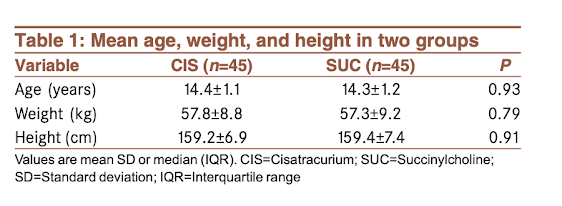Comparison of Succinylcholine and Cisatracurium: New Study From Iran
Out on PubMed, from clinicians in Iran, is this study:
Comparison of hemodynamic changes and serum potassium levels in the use of succinylcholine and cisatracurium in electroconvulsive therapy.
Background: Electroconvulsive therapy (ECT) is nowadays used commonly as one the most effective treatment methods in psychiatric disorders. In patients undergoing ECT, succinylcholine is usually used. In addition, cisatracurium is occasionally used on a case report basis globally. In this study, we compared the hemodynamic changes and serum potassium levels in the use of succinylcholine and cisatracurium in ECT.
Materials and methods: The current crossover clinical trial was performed on 45 patients who were candidates for ECT between 2017 and 2018. The patients were given succinylcholine or cisatracurium randomly on two separate occasions of ECT. The independent t-test and Chi square Test were used to compare the data.
Results: Comparison of mean systolic blood pressure (P = 0.14), diastolic blood pressure (P = 0.33), and mean arterial pressure (P = 0.23) did not show any significant difference between the two groups. The induced seizure duration (P = 0.002), return of spontaneous respiratory from seizure ending (P = 0.001), and apnea duration (P = 0.01) were significantly higher in the cisatracurium group compared to the succinylcholine group. However, the frequency of tachycardia in cisatracurium group was lower than the succinylcholine group (P < 0.001). In addition, the serum potassium level had a significant difference (P < 0.001) between the two groups.
Conclusion: Using cisatracurium can be an alternative to succinylcholine during ECT since it causes less elevation in serum potassium and creates a longer duration of induced seizure, more rapid re emergence of spontaneous breathing at the end of seizure (P = 0.001), and a lower prevalence of tachycardia compared to succinylcholine (P < 0.001).
Keywords: Cisatracurium; electroconvulsive therapy; hyperkalemia; serum potassium; succinylcholine.
The abstract is copied below:Background: Electroconvulsive therapy (ECT) is nowadays used commonly as one the most effective treatment methods in psychiatric disorders. In patients undergoing ECT, succinylcholine is usually used. In addition, cisatracurium is occasionally used on a case report basis globally. In this study, we compared the hemodynamic changes and serum potassium levels in the use of succinylcholine and cisatracurium in ECT.
Materials and methods: The current crossover clinical trial was performed on 45 patients who were candidates for ECT between 2017 and 2018. The patients were given succinylcholine or cisatracurium randomly on two separate occasions of ECT. The independent t-test and Chi square Test were used to compare the data.
Results: Comparison of mean systolic blood pressure (P = 0.14), diastolic blood pressure (P = 0.33), and mean arterial pressure (P = 0.23) did not show any significant difference between the two groups. The induced seizure duration (P = 0.002), return of spontaneous respiratory from seizure ending (P = 0.001), and apnea duration (P = 0.01) were significantly higher in the cisatracurium group compared to the succinylcholine group. However, the frequency of tachycardia in cisatracurium group was lower than the succinylcholine group (P < 0.001). In addition, the serum potassium level had a significant difference (P < 0.001) between the two groups.
Conclusion: Using cisatracurium can be an alternative to succinylcholine during ECT since it causes less elevation in serum potassium and creates a longer duration of induced seizure, more rapid re emergence of spontaneous breathing at the end of seizure (P = 0.001), and a lower prevalence of tachycardia compared to succinylcholine (P < 0.001).
Keywords: Cisatracurium; electroconvulsive therapy; hyperkalemia; serum potassium; succinylcholine.
The pdf is here.
I was hopeful that this would be an interesting and useful addition to the ECT anesthesia literature. Unfortunately, not so. You have to read this paper closely to know that it is a study of 90 child and adolescent patients treated with ECT in a pediatric hospital over a period of 2 years. Hmmmmmm....There are many other red flags about this paper, including the phrase "A Thymatron intravenous[sic] device was used for ECT." The only finding I might trust from this study is that potassium levels were slightly higher with cisatracurium than succinylcholine.
Nothing to see here, and no need to read this paper, IMO.





Comments
Post a Comment